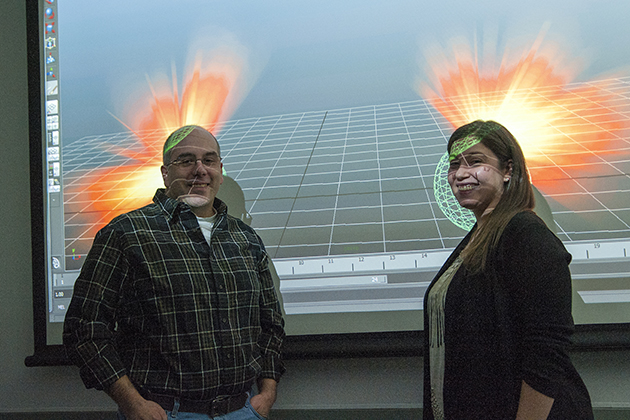
The basement of the Bishop Center might not be the likeliest venue for regular displays of magic, but that’s what seems to happen when new associate professors-in-residence Perry Harovas and Samantha Olschan work together.
On computer screens, pictures dissolve and turn into flocks of birds. On an interior wall, an animated projection flips through facts about heart health while students watch. And Olschan and Harovas, each with a lengthy private sector resume in their respective fields, bring a strong focus on collaboration to the newly established Department of Digital Media and Design.
“It’s like creative ping-pong,” Olschan says. “We bounce ideas off each other all the time.”
Looking over his shoulder as he fine tunes another animation project, Harovas chimes in: “Some people want to stay isolated in their own little area, and we really don’t work that way.”
Harovas and Olschan arrived on campus in the fall just as the new department was launching under the direction of Professor Tim Hunter. With six faculty members and 135 students so far, the department is helping position UConn at the forefront of digital media and design, a field that’s as diverse as it is dynamic.
“The only thing I can say about the industry for sure is that it will be different tomorrow from what it is today,” says Harovas, whose experience before coming to UConn included ownership of two visual effects companies and serving as an instructor at New York University.
Part of the reason the field is changing so rapidly is because there are so many potential applications for the work done by digital media professionals, says Olschan, who did everything from working as a broadcast designer at Fox News to teaching classes at Wesleyan University before arriving at UConn.
“I’m teaching students from engineering, art students, students from business, from graphic design,” she says. “For me, imagination is the building block regardless of what field you’re in, and a lot of what we do is develop those conversations across the disciplines.”
Some of those conversations include evangelizing for the benefits of digital media in disciplines where people might not suspect their work would make an ideal fit with the field.
As an example, Harovas points to the project he’s guiding a student on, in which animations of cell structures are being produced for a class taught by Mary Bruno, assistant professor-in-residence of molecular and cell biology.
“Biochemistry students who take that class, when they find out a student worked to make that animation, can really start to see some of the possibilities in applying our work to different areas,” he says.
That kind of work is precisely what Hunter calls the “four-legged table” model of digital media and design: ”The four components are artistic creativity, business, STEM – or science, technology, engineering, and math, and the digital humanities/social sciences. No barriers, no boundaries.”
Working with students in other disciplines to think in new ways has actually been one of the most invigorating aspects of her work so far, Olschan has found.
“I’m really happy with the work from my engineers and my computer scientists,” she says. “They’re really delivering when it comes to thinking creatively about applying digital media to their work.”
The transdisciplinary work will ramp up this fall, when UConn starts offering two new degrees in digital media and design: students at Storrs and Stamford will be able to obtain either a Bachelor of Arts or a Bachelor of Fine Arts degree, and there are plans to develop master’s degrees as well as four-course post-baccalaureate certificates.
The University community can also get a look at some cutting-edge work in the field on Thursday, April 4, at a daylong symposium on digital media and design in the Rome Commons Ballroom.



